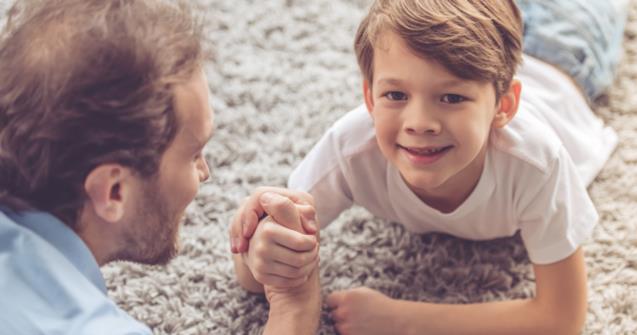
Communicating with our body
Key experiences for babies and toddlers-Communication
This key experience focuses on nonverbal communication, communication that uses body language instead of words to express a message.
Body language in young children
Nonverbal communication is very important for young children. Since words don't appear before the end of their first year of life, babies and toddlers learn to use nonverbal communication to express themselves through a smile, a look, a touch, etc.
By the time they are toddlers, children have developed great nonverbal skills. They can observe the reactions of others and seek their consent through nonverbal communication. With a simple look or through the analysis of another toddler's posture, children can determine if, for example, he is willing to share the blocks he is playing with.
With adults
Nonverbal communication between adults and younger children is very important. Simply by looking at you, babies and toddlers can recognize your joy. If, for example, a child is afraid of a dog on the other side of the street, your calm face can be reassuring.
The advantages of nonverbal communication
Nonverbal communication makes decoding and expressing emotions easier. It can also support or confirm a verbal message, allow a child to explain an opinion without using words, and help him communicate more efficiently with a person who is not understanding his words.
Activities related to the key experience: Communication with your body
Learning to trade objects is a great way to teach babies and toddlers to communicate. Just like in a conversation, the following activity will help children understand the concept of "yours" and "mine".
Exchanging a ball
Sit in front of a baby and roll a ball towards him. Encourage him to send the ball back to you. Two toddlers can enjoy this simple activity together.
Communicating with your hands
Practice saying "hello" and "goodbye" using your hands in various settings and situations as well as with different people.
Children will enjoy waving:
- To their parents when they leave or arrive.
- To their early childhood educator who is leaving the room for her break.
- To strangers walking in front of the daycare (through the window).
- To the people you meet when you go out for walks.
You may also hide within your daycare and wave to children instead of simply playing traditional peek-a-boo games.
Communicating with your hands (2)
Have fun clapping your hands together to express happiness. Children will follow along.
Communicating with your fingers
Point to an object within children's line of sight, but out of their reach. Hang various posters from the ceiling within your daycare and point to them. Outside, have fun pointing to birds, butterflies, airplanes, etc.
Communicating with your head
Practice moving your head side to side to say "no" and up and down to say "yes" whenever appropriate. Make this activity fun by exaggerating your movements.
Communicating with your face
Have fun making silly faces with the children in your group.
Communicating with your face (2)
In front of a mirror, use your face to mime different emotions: angry, happy, sad, surprised, etc.
Communicating with your face (3)
Before naptime, use your face to show children you are tired. Yawn, stretch out your arms and lie down on the floor.
Communicating with your eyes
Tap into the playful side of your personality. Sit in a circle on the floor with your group and have fun winking at the children in your group. Smile at them too. This will help them understand that this is a friendly gesture.
Look at pictures that represent different emotions
Use books to show children pictures representing different emotions. Name them as you turn the pages. You can also stick pictures on a mirror and have fun acting out the various emotions nonverbally.
Puppets
I love giving a puppet to parents when their child is born. Puppets can be used for hours of fun with their baby. Puppets can be used to tickle children and teach them about different emotions. Babies will enjoy this form of nonverbal communication.
Sign language
Sign language can help babies and toddlers communicate before they can speak. There are many articles and books that can be used to learn the basics.
Illustrated actions
I would like to suggest a simple imitation game that is great for developing body language with older toddlers. Begin by teaching them to imitate you. Take pictures of different people executing various simple actions such as touching their feet, hopping up and down, hiding their eyes, etc. Without saying a word, touch your feet like in the first picture. Once children have understood how this activity works, explore pictures representing different emotions they can imitate (tired, happy, sad).
Reacting to nonverbal emotions
When a baby is sad, you hold him in your arms. Introduce a simple imitation game with toddlers. You can, for example, tell them your dolls or stuffed animals are sad and invite them to hold them to comfort them. You may also encourage them to express joy and affection by inviting toddlers to hug dolls or stuffed animals.
Chantal Millette
Early childhood educator

 Home
Home Theme activities
Theme activities
 Babies and toddlers
Babies and toddlers
 Arts and crafts
Arts and crafts
 Science
Science
 Creative recipes
Creative recipes
 Tips and tricks
Tips and tricks
 Special needs
Special needs
 Extra activities
Extra activities
 Educ-TV
Educ-TV
 Newsletter
Newsletter  Online store
Online store Educatall club
Educatall club

